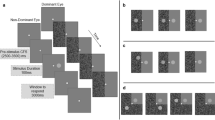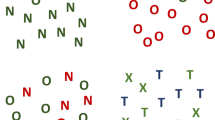Abstract
One important, yet relatively unexplored question is whether blindsight, i.e., unconscious visually guided behavior in hemianopic patients, is endowed with basic perceptual properties such as detecting stimulus numerosity and overall configuration. Rather than a forced-choice procedure in which patients are supposed to guess about stimuli presented to the blind hemifield, we used a redundant signal effect paradigm, i.e., the speeding of simple reaction time (RT) when presenting multiple versus single similar stimuli. The presence of an effect of numerosity for the (unseen) stimuli presented to the blind field was indirectly assessed by measuring RT to bilateral versus unilateral stimuli presented to the intact hemifield. Chronic hemianopic patients were tested with unilateral or bilateral black dots, both of which could be either single or quadruple. The latter could either have a fixed spatial configuration representing a diamond or be randomly spatially assembled on every trial. Both configurations covered the same extent of visual field and had the overall same luminance. We found that a numerosity effect as a result of increasing the number of stimuli in the blind field was indeed present but only with the diamond configuration. This is a convincing evidence that this form of blindsight does not depend upon stimulus numerosity per se but is likely to be related to the presence of structured and memorized rather than meaningless changing stimuli.



Similar content being viewed by others
References
Bridge H, Thomas O, Jbabdi S, Cowey A (2008) Changes in connectivity after visual cortical brain damage underlie altered visual function. Brain 13:1433–1444
Celeghin A, Barabas M, Mancini F, Bendini M, Pedrotti E, Prior M, Cantagallo A, Savazzi S, Marzi CA (2015) Speeded manual responses to unseen visual stimuli in hemianopic patients: what kind of blindsight? Conscious Cogn 32:6–14
Corbetta M, Marzi C, Tassinari G, Aglioti S (1990) Effectiveness of different task paradigms in revealing blindsight. Brain 113:603–616
Danckert J, Rossetti Y (2005) Blindsight in action: what can the different sub-types of blindsight tell us about the control of visually guided actions? Neurosci Biobehav Rev 29:1035–1046
Leh SE, Johansen-Berg H, Ptito A (2006) Unconscious vision: new insights into the neuronal correlate of blindsight using diffusion tractography. Brain 129:1822–1832
Leh SE, Ptito A, Schönwiesner M, Chakravarty MM, Mullen KT (2010) Blindsight mediated by an S-cone-independent collicular pathway: an fMRI study in hemispherectomized subjects. J Cogn Neurosci 22:670–682. doi:10.1162/jocn.2009.21217
Leopold DA (2012) Primary visual cortex: awareness and blindsight. Annu Rev Neurosci 35:91–109
Marcel AJ (1998) Blindsight and shape perception: deficit of visual consciousness or of visual function? Brain 121:1565–1588
Marzi CA (1999) The Poffenberger paradigm: a first, simple, behavioral tool to study interhemispheric transmission in humans. Brain Res Bull 50:421–422
Marzi CA, Tassinari G, Aglioti S, Lutzemberger L (1986) Spatial summation across the vertical meridian in hemianopics: a test of blindsight. Neuropsychologia 24:749–758
Marzi CA, Bisiacchi P, Nicoletti R (1991) Is interhemispheric transfer of visuomotor information asymmetric? Evidence from a meta-analysis. Neuropsychologia 29:1163–1177
Marzi CA, Mancini F, Metitieri T, Savazzi S (2009) Blindsight following visual cortex deafferentation disappears with purple and red stimuli: a case study. Neuropsychologia 47:1382–1385. doi:10.1016/j.neuropsychologia.2009.01.023
Nguyen MN, Mtsumoto J, Hori E, Maior RS, Tomaz C, Tran AH, Ono T, Nishijo H (2014) Neuronal responses to face-like and facial stimuli in the monkey superior colliculus. Front Behav Neurosci 8:85. doi:10.3389/fnbeh.2014.00085 (eCollection 2014)
Overgaard M (2011) Visual experience and blindsight: a methodological review. Exp Brain Res 209:473–479. doi:10.1007/s00221-011-2578-2
Perez C, Chokron S (2014) Rehabilitation of homonymous hemianopia: insight into blindsight. Front Integr Neurosci 8:82. doi:10.3389/fnint.2014.00082 (eCollection 2014)
Poppel E, Held R, Frost D (1973) Residual visual function after brain wounds involving the central visual pathways in man. Nature 243:295–296
Silvanto J (2014) Why is “blindsight” blind? A new perspective on primary visual cortex, recurrent activity and visual awareness. Conscious Cogn 32:15–32. doi:10.1016/j.concog.2014.08.001
Tamietto M, Cauda F, Corazzini LL, Savazzi S, Marzi CA, Goebel R, Weiskrantz L, de Gelder B (2010) Collicular vision guides nonconscious behavior. J Cogn Neurosci 22:888–902. doi:10.1162/jocn.2009.21225
Tamietto M, Pullens P, de Gelder B, Weiskrantz L, Goebel R (2012) Subcortical connections to human amygdala and changes following destruction of the visual cortex. Curr Biol 22:1445–1449
Tomaiuolo F, Ptito M, Marzi CA, Paus T, Ptito A (1997) Blindsight in hemispherectomized patients as revealed by spatial summation across the vertical meridian. Brain 120:795–803
Torjussen T (1978) Visual processing in cortically blind hemifields. Neuropsychologia 16:15–21
Urbanski M, Coubard OA, Bourlon C (2014) Visualizing the blind brain: brain imaging of visual field defects from early recovery to rehabilitation techniques. Front Integr Neurosci 8:74. doi:10.3389/fnint.2014.00074 (eCollection 2014)
Weil RS, Plant GT, James-Galton M, Rees G (2009) Neural correlates of hemianopic completion across the vertical meridian. Neuropsychologia 47:457–464. doi:10.1016/j.neuropsychologia.2008.09.020
Weiskrantz L (1990) The Ferrier lecture, 1989. Outlooks for blindsight: explicit methodologies for implicit processes. Proc R Soc Lond B Biol Sci 239:247–278
Weiskrantz L (1996) Blindsight revisited. Curr Opin Neurobiol 6:215–220
Weiskrantz L (2004) Roots of blindsight. Prog Brain Res 144:229–241
Weiskrantz L, Warrington EK, Sanders MD, Marshall J (1974) Visual capacity in the hemianopic field following a restricted occipital ablation. Brain 97:709–728
Acknowledgments
The study was in part supported by ERC Advanced Grant ‘Perceptual Awareness’ (C.A.M).
Conflict of interest
The authors declare that they have no conflict of interest.
Author information
Authors and Affiliations
Corresponding author
Rights and permissions
About this article
Cite this article
Celeghin, A., Savazzi, S., Barabas, M. et al. Blindsight is sensitive to stimulus numerosity and configuration: evidence from the redundant signal effect. Exp Brain Res 233, 1617–1623 (2015). https://doi.org/10.1007/s00221-015-4236-6
Received:
Accepted:
Published:
Issue Date:
DOI: https://doi.org/10.1007/s00221-015-4236-6




